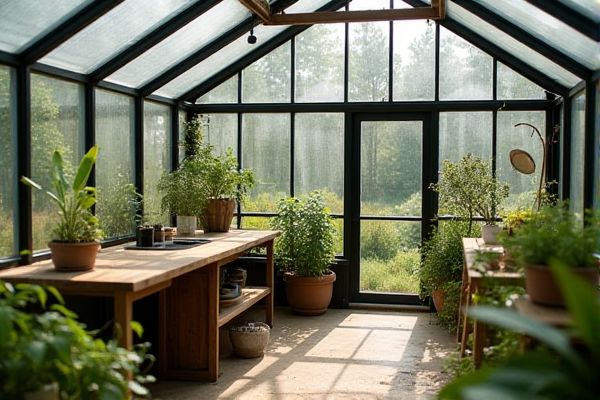
A cold frame provides a simple, low-cost way to protect plants from frost and extend the growing season, while a mini greenhouse offers a more controlled environment with greater temperature and humidity regulation for year-round gardening. Discover how these options can suit Your gardening needs by exploring the full article.
Table of Comparison
| Feature | Cold Frame | Mini Greenhouse |
|---|---|---|
| Structure | Low, single-layer frame with transparent top | Small, portable greenhouse with multiple panels |
| Purpose | Extend growing season; protect plants from cold | All-season growing; protects from cold, pests, and environment |
| Material | Wood or metal frame with glass or plastic cover | Plastic or metal frame with clear plastic panels |
| Temperature Control | Relies on passive solar heating; limited ventilation | Better ventilation and temperature regulation options |
| Size | Typically small and low to the ground | Varies, usually taller and larger than cold frames |
| Mobility | Usually stationary; heavier materials | Portable and lightweight options available |
| Cost | Low to moderate | Moderate to higher |
| Best For | Seed starting, hardening off plants in cool climates | Year-round growing, larger variety of plants |
Understanding Cold Frames and Mini Greenhouses
Cold frames are low, box-like structures with transparent lids that trap solar energy to extend your growing season by protecting plants from frost and cold weather. Mini greenhouses, often taller with multiple shelves and full enclosures, provide controlled environments that regulate temperature, humidity, and light for seedlings and tender plants. Understanding these differences helps you choose the right option to optimize plant growth and maximize gardening success.
Key Differences Between Cold Frames and Mini Greenhouses
Cold frames are low-profile structures primarily designed to protect plants from frost and extend the growing season by using soil warmth, while mini greenhouses are taller, enclosed units that offer more space for vertical growth and better temperature control with ventilation options. Unlike cold frames, mini greenhouses often include shelves and zippered or hinged doors, allowing for easier access and enhanced humidity regulation. Your choice depends on available space, plant types, and desired growing conditions, with cold frames suited for hardening off seedlings and mini greenhouses ideal for year-round cultivation.
Design and Structure Comparison
Cold frames feature a low-profile, box-like design with a transparent lid that allows sunlight to enter while trapping heat, making them ideal for ground-level gardening. Mini greenhouses often have taller, freestanding structures with multiple shelves and a zippered cover to maximize vertical growing space and airflow control. Your choice depends on available space and the type of plants you want to protect during cooler seasons.
Ideal Uses for Cold Frames
Cold frames are ideal for extending the growing season by protecting seedlings and young plants from frost and harsh weather conditions. They provide a controlled microclimate that supports seed starting, hardening off plants, and growing cold-tolerant vegetables like spinach and kale. Unlike mini greenhouses, cold frames are low-profile structures that require minimal space and energy for efficient temperature regulation.
Best Applications for Mini Greenhouses
Mini greenhouses excel in providing controlled environments for young plants, extending the growing season, and protecting delicate seedlings from pests and harsh weather conditions. Ideal for urban gardeners and small spaces, they allow for temperature regulation and humidity control, which enhance plant growth and improve germination rates. Their portability and transparency make them perfect for starting vegetables, herbs, and flowers early in the season.
Climate Control and Temperature Management
Cold frames provide basic climate control by trapping solar heat and protecting plants from frost, making them ideal for early-season temperature management. Mini greenhouses offer enhanced temperature regulation with adjustable vents and sometimes heating elements, allowing better airflow and consistent warmth. Your choice depends on the level of climate control needed for your plants and the local weather conditions.
Cost Considerations: Cold Frame vs Mini Greenhouse
Cold frames generally offer a more budget-friendly option for extending your growing season, with costs ranging from $50 to $200 depending on size and materials. Mini greenhouses tend to be pricier, often between $100 and $500, due to their larger structure and added features like ventilation and shelving. Choosing between a cold frame and a mini greenhouse depends on your budget and the level of protection and space you need for your plants.
Space Requirements and Placement Tips
Cold frames require minimal space, making them ideal for small gardens or patios, while mini greenhouses need more room due to their taller structure. Position cold frames in a south-facing spot to maximize sunlight absorption and protect plants from wind, whereas mini greenhouses benefit from a location with consistent airflow to prevent overheating. Both structures should be placed on level ground with easy access to water sources for optimal plant growth.
Pros and Cons of Cold Frames
Cold frames offer a low-cost, energy-efficient way to extend your growing season by protecting plants from frost and wind. They provide natural ventilation and are easy to use but may require regular monitoring to avoid overheating on sunny days and limited space compared to mini greenhouses. While cold frames are ideal for hardening off seedlings, they lack the versatility and larger capacity of mini greenhouses, making them better suited for smaller gardening needs.
Advantages and Disadvantages of Mini Greenhouses
Mini greenhouses offer extended growing seasons by providing controlled temperature and humidity, promoting healthy plant growth and protection from pests. However, they require regular maintenance, proper ventilation to prevent mold, and can be more expensive compared to cold frames. Your choice depends on the level of climate control and space efficiency you need for your gardening goals.
 homyna.com
homyna.com